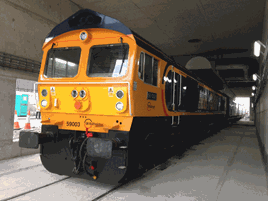The decline of coal is presenting a host of interesting dilemmas for the energy industry, as it seeks new ways to fuel its power stations.
Key to this will be biomass. But innovative ways will need to be found to enable rail to move the product across what will be (one day) the area covered by the ‘Northern Powerhouse’.
GB Railfreight started moving biomass in 2010, transporting the product from various east coast ports to feed power stations along the eastern side of the UK. (RAIL travelled with one such train from Port of Tyne last year, RAIL 751). And there has been significant investment by many companies, as rail and the energy sector look to develop this method of fuel.
Biomass looks like chicken pellets. It is shipped from the Americas (usually North America), and arrives in ports that are large enough to accommodate deep-sea vessels.
However, considering the UK is an island, there are not as many of these as you might think. Much like on the railway, capacity is also an issue at ports. Biomass is just one more product in a long list of imported goods vying for space not only on the railway, but also at ports.
GBRf ran its first train for Drax Power from the North West on October 26 (RAIL 787). The freight company has been operating in the region for many years, and this new train adds to the company’s portfolio. It runs from Port of Liverpool to Drax Power station (near Selby, in North Yorkshire), and carries 1,600 tonnes of biomass.
The freight company explained in a statement: “The Port of Liverpool is a loading location included on GBRf’s contract for hook and haul services with Drax Power. GBRf currently runs two sets of Drax wagons.”
59003 Yeoman Highlander, with 66706 Nene Valley on the rear, hauled the first train - it was formed of 25 of Drax Power’s biomass wagons, and left the Port at 1725 on October 26. The ‘59’ took the train up the steep bank to Tuebrook sidings (near Edge Hill), from where the ‘66’ continued the working. The train arrived at Drax Power Station at 0159 the following morning.
This is just the first part (Phase 1) of a grand five-year plan. The next phase will be completed next year - GBRf says the objective is to stimulate greater throughput at the new terminal, increasing trains from this location and ultimately using four sets of wagons to move up to three million tonnes of biomass per annum from Liverpool (Peel Ports) to Drax Power Station. The power station produced 12% of all of the UK’s renewable electricity in 2014.
GBRf Managing Director John Smith tells RAIL that the plan is for three sets to be used, working out at one and a half trips every 24 hours. “On a scale it is big, but not our biggest,” he says of the contract.
Smith explains that the Class 59/0 is being used for its haulage capabilities. It was not bought specifically for that reason, but since there is a lot of volume per train and a steep climb from Port of Liverpool, it makes sense to use the locomotive for the time being.
This new contract will also provide a massive boost for the region. The Liverpool Echo reported that 300 jobs would be created in the supply chain as a result. Meanwhile, related work at the Merseyside port, which is owned by Peel Ports, includes construction of a rail loading facility and a 100,000-tonne storage capacity.
The actual terminal is owned and operated by Ligna Biomass, which itself is owned by the shareholders of Peel Ports. It does not become fully operational until next July (Phase 2), at which point up to ten trains per day can run to north Yorkshire.
Work is still needed at the Port, however. “The railway runs parallel along the docks,” explains Smith. “The access is via a single 90° steel climb. I’m not sure what it is, maybe 1-in-100. So you start at 0mph on a curve, and the train is longer than others we run to Ironbridge. We are lobbying for this to be improved. There is a level crossing, and we want double track from that.”
Smith says funding for this would come from the Strategic Freight Network, which is designed to support such projects.
A major challenge has been to establish the paths for this new flow. A Rail Freight Group (RFG) report reveals that 58% of respondents to a recent survey believed that lack of suitable paths was a barrier to the growth of rail freight.
And the operation of these new trains certainly shows the length the industry needs to go to in order to operate freight. In recent years, the majority of freight crossing the Pennines has been residual traffic - the remnants of flows that had been running for years. There has not been a dedicated freight route since Woodhead closed in 1981 (passenger trains ended on that line in 1970).
















Login to comment
Comments
FrankH - 02/02/2016 11:35
Another route could be to Warrington BQ as now then WCML to Farington Jnct then the East Lancs line via copy pit into yorkshire rejoining the original route at Wakefield. Maybe longer mileage wise but there's not a lot of traffic uses the route.
FrankH - 03/02/2016 12:03
There's a Doncaster -Preston - Doncaster light engine move via the copy pit route 2nd and 3rd Feb, It could be GBRF route training as Colas allready run this way with bitumin for preston docks.
FrankH - 28/02/2016 23:17
The first time I've seen it in the schedule, Doncaster Decoy yard via calder valley to Farington jnct, WCML to parkside Jnct then St Helens to Liverpool Bulk terminal. 3hrs 20 mins.